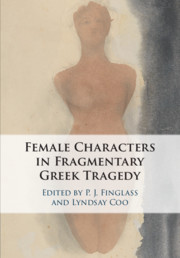Book contents
- Female Characters in Fragmentary Greek Tragedy
- Female Characters in Fragmentary Greek Tragedy
- Copyright page
- Contents
- Notes on Contributors
- Preface
- Abbreviations
- 1 Introduction
- Part I Themes
- Part II Plays
- 7 Dancing on the Plain of the Sea
- 8 Europa Revisited
- 9 When Mothers Turn Bad
- 10 The Music One Desires
- 11 Fragmented Self and Fragmented Responsibility
- 12 Female Agency in Euripides’ Hypsipyle
- 13 Making Medea Medea
- Bibliography
- General Index
- Index of main female characters discussed
10 - The Music One Desires
Hypsipyle and Aristophanes’ ‘Muse of Euripides’
from Part II - Plays
Published online by Cambridge University Press: 11 June 2020
- Female Characters in Fragmentary Greek Tragedy
- Female Characters in Fragmentary Greek Tragedy
- Copyright page
- Contents
- Notes on Contributors
- Preface
- Abbreviations
- 1 Introduction
- Part I Themes
- Part II Plays
- 7 Dancing on the Plain of the Sea
- 8 Europa Revisited
- 9 When Mothers Turn Bad
- 10 The Music One Desires
- 11 Fragmented Self and Fragmented Responsibility
- 12 Female Agency in Euripides’ Hypsipyle
- 13 Making Medea Medea
- Bibliography
- General Index
- Index of main female characters discussed
Summary
Usually marking moments of elevated emotion, tragic song is used to powerful effect in the characterisation of both male and female (non-choral) characters, but is more strongly associated with the latter, in part owing to the associations of ritual lament as a women’s genre. This chapter analyses a notable instance of female song in Euripides, the titular figure’s monody in Hypsipyle. This character’s song came to be viewed as so representative of the playwright’s New Musical tendencies that she was parodied in Aristophanes’ Frogs as ‘the Muse of Euripides’. A detailed reading of both the monody itself and Hypsipyle’s Aristophanic reception blends the study of mousikē, aesthetics, synaesthesia, and cult to show how Euripides’ singing heroine absorbs the audience into her desire for a form of music marked as Asian, Orphic, and citharodic, and which forges a continuous chain between the musical culture of Lemnos and Euripides’ contemporary Athens. In this interpretation, Hypsipyle’s song showcases not just the playwright’s skill in the creation of a virtuosic female voice, but also his use of female song to create a link to the political realities of the world of the audience.
Keywords
- Type
- Chapter
- Information
- Female Characters in Fragmentary Greek Tragedy , pp. 162 - 178Publisher: Cambridge University PressPrint publication year: 2020

